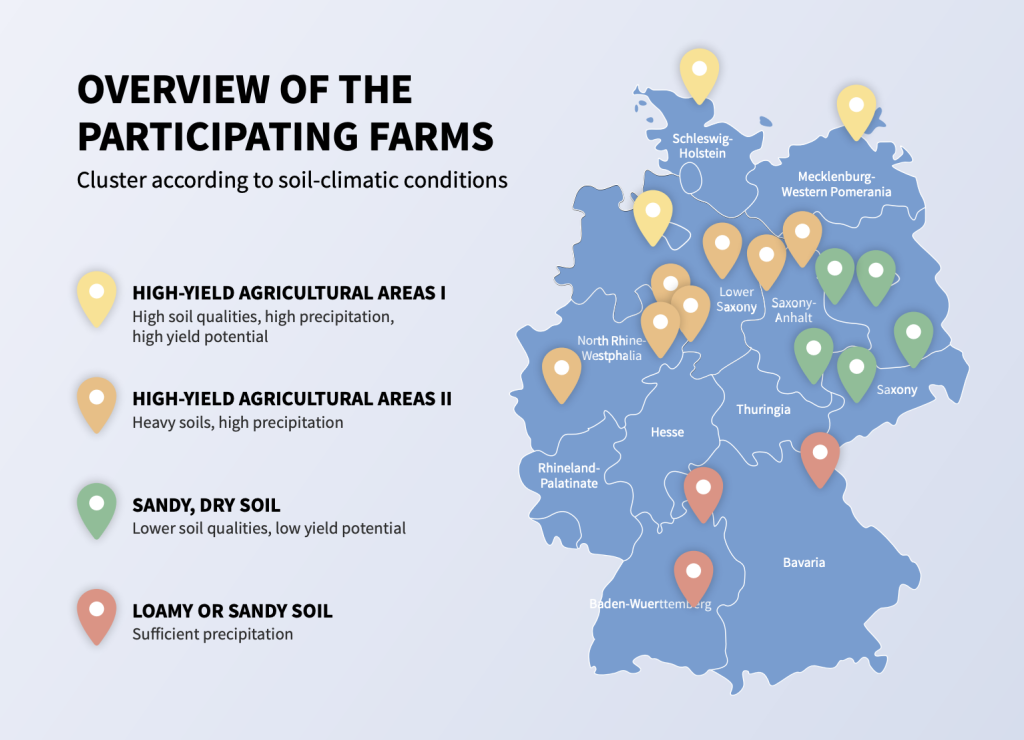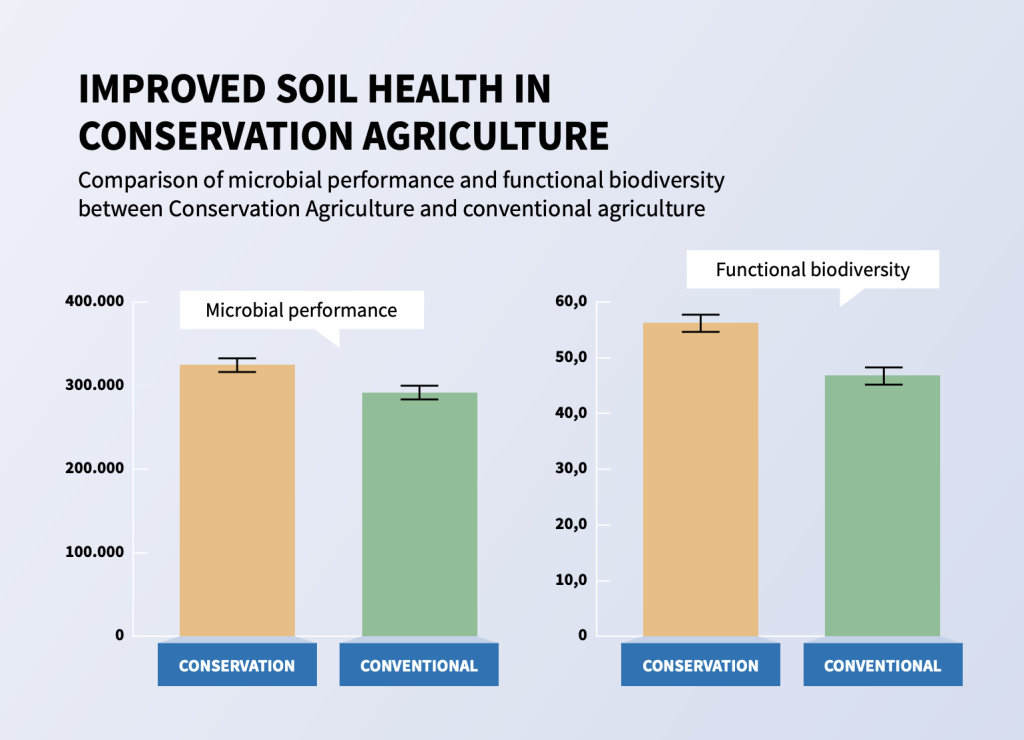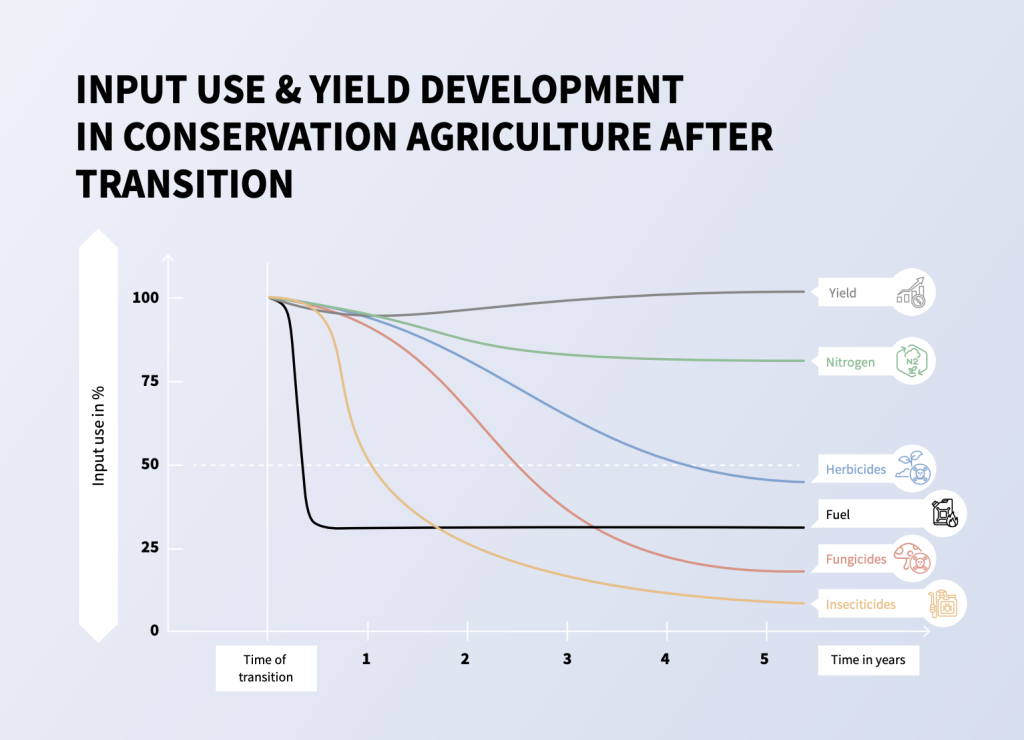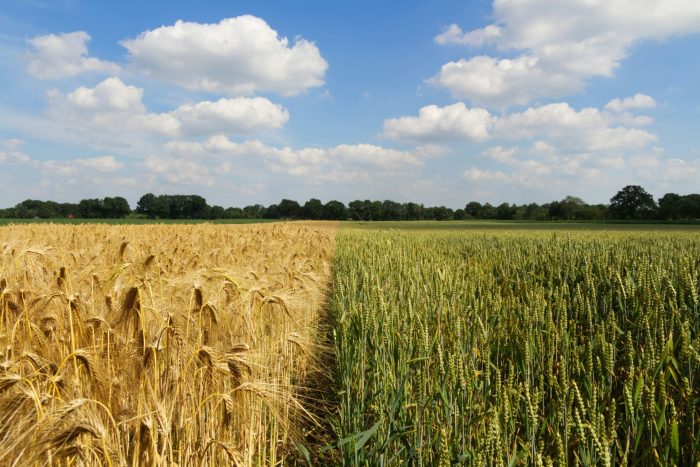Introduction
Across Europe, agriculture is undergoing a profound transformation. Decades of intensive farming have delivered high yields – but often at a high price. Soil degradation, biodiversity loss, and rising production costs are pushing farmers and policymakers alike to rethink how we grow food.
Germany, like many EU countries, is feeling this pressure acutely. In response, the Nature and Biodiversity Conservation Union (NABU), in cooperation with the Society for Conservation Tillage (GKB) and Weihenstephan-Triesdorf University of Applied Sciences, launched a study to investigate a promising solution: Conservation Agriculture (CA).
The goal? To test whether a systematic and consistent approach to farming could help reverse soil degradation and declining farm profitability. Crucially, the study also placed soil biology in the spotlight, using BIOTREX analysis to measure how microbial life responds to Conservation Agriculture in practice.
Soil Degradation and Biodiversity Loss: Ecosystem Under Pressure
Decades of intensive cultivation practices – including deep tillage, simplified crop rotations, and heavy reliance on synthetic inputs – have placed significant strain on Europe’s soils. In Germany, the impacts are particularly pronounced. According to NABU’s recent report, the agricultural sector is responsible for approximately 8% of the country’s direct greenhouse gas emissions, with an additional 36.5 million tonnes of CO₂ released annually due to soil degradation – primarily from the drainage of peatlands. At the same time, biodiversity across agricultural landscapes is declining rapidly, both above and below the soil surface.
This degradation is more than a loss of ecological value – it directly undermines the functionality of the soil system. At the centre of this system are microorganisms, which play a fundamental role in maintaining soil health.
These microbial communities regulate nutrient cycling, suppress plant pathogens, break down organic matter, and contribute to the formation of stable soil structure. However, when soils are repeatedly disturbed and inadequately protected, these communities are disrupted – compromising the soil’s biological integrity and overall performance.
The consequences are far-reaching:
- Reduced capacity for water retention and nutrient availability
- Increased vulnerability to pests and diseases
- Heightened dependency on chemical fertilisers and pesticides
These ecological challenges are compounded by rising input costs and evolving regulatory demands, including EU targets for emissions and biodiversity conservation. Together, they highlight a pressing need to transition toward more resilient and biologically grounded farming systems – beginning with the soil itself.
Conservation Agriculture: A Smart Way to Farm
Conservation Agriculture is a farming system designed to reduce disturbance to soil ecosystems, enhance biodiversity, and improve resilience. It is based on three core principles defined by the FAO:
- Minimal soil disturbance – no-till or direct drilling.
- Permanent ground cover – using cover crops or mulch to protect the soil all year.
- Diverse crop rotations – breaking monocultures to support soil life and plant health.
Although conservation, regenerative, and organic farming are often used interchangeably, the terms represent distinct approaches, each with its own focus and underlying principles. Regenerative agriculture is goal-driven, focusing on rebuilding soil fertility, increasing biodiversity, and capturing carbon. Organic farming, on the other hand, is defined by strict regulatory standards that prohibit synthetic inputs, but it frequently relies on intensive tillage for weed control.
In contrast, CA offers a method-focused approach that can be adopted by both conventional and organic farms.
And it’s already being used – just not widely enough. In Germany, conservation tillage is common, but complete CA approach is still rare, covering only about 1% of arable land.
The Study: Testing Conservation Agriculture in the Field
The aim of the study was to assess the ecological and economic impacts of fully implementing Conservation Agriculture under real-world conditions.
To achieve this, the project team analysed data from 17 farms across Germany that had already adopted full CA practices. Each farm had been using no-till methods, permanent cover, and diverse crop rotations for at least three years.
The farms grew key arable crops – winter wheat, winter barley, maize, and oilseed rape – under CA conditions. Each was compared to conventional farms in the same regions.

Overview map of participating farms and corresponding clustering of similar soil and climate conditions.
Source: Healthier Soils, Lower Costs, Sustainable Yields: How Conservation Agriculture Reaps Benefits. (2025). NABU (Nature and Biodiversity Conservation Union) e. V.
The study collected data on:
- Pesticide use
- Nitrogen input
- Fuel consumption
- Yields
- Soil biology
To assess soil microbial activity and functional diversity, BIOTREX Soil Microbial Analysis was used on six of the seventeen farms in this study. To ensure comparability, each Conservation Agriculture plot was paired with an adjacent conventionally managed field, allowing soil and climatic conditions to be held constant while isolating the effects of farming practices. Sampling was conducted between August and September 2023.
This design enabled a detailed, statistically grounded comparison between systems, bridging agronomy, economics, and ecology.
How Conservation Agriculture Can Affect Soil Microbes
Before presenting the results, it is useful to consider how the three core principles of Conservation Agriculture may influence the soil microbial community. Soil life, including bacteria, fungi and other microscopic organisms, is central to soil health. These microorganisms drive nutrient cycling, suppress plant pathogens, decompose organic matter and contribute to the formation and stability of the soil’s structure.
Conservation Agriculture creates supporting conditions for these organisms:
- Minimal disturbance protects soil aggregates and habitats, allowing fungi and bacteria to form stable, synergistic relationships with plant roots.
- Permanent cover – whether living or mulched – moderates soil temperature, retains moisture, and supplies a continuous flow of carbon-rich organic matter.
- Diverse crops foster a wider range of root exudates and microbial niches, boosting functional diversity.
The result is a thriving underground ecosystem that improves nutrient cycling, disease resistance, and soil structure. These improvements are not merely theoretical. With the use of microbial testing tools like BIOTREX, such changes can now be quantified and tracked across time and management systems.
Results: Biodiversity, Inputs, and Economic Performance
The study revealed a clear, consistent pattern: CA supports both biological health and economic performance.
Soil microbial community and biodiversity
- Microbial performance was significantly higher under CA (331,052 ± 8,896) compared to conventional systems (298,000).
- Functional biodiversity, which reflects the diversity of microbial roles, was also significantly higher (56.1 vs. 45.9).
- Earthworm populations were up to 3.8× higher in CA fields, reflecting improved soil structure and organic matter breakdown.

Microbial performance (left) and functional soil biodiversity (right) compared in conservation and conventional agriculture.
Source: Healthier Soils, Lower Costs, Sustainable Yields: How Conservation Agriculture Reaps Benefits. (2025). NABU (Nature and Biodiversity Conservation Union) e. V.
Inputs use reduction
- Pesticide toxicity was reduced by an average of 52% across all crops (up to 71% in winter wheat).
- Nitrogen fertiliser use fell by 15.2% overall – with winter wheat showing the largest reduction (23.3%).
- Fuel consumption dropped by 74% compared to conventional ploughing systems, due to reduced passes and no-till sowing.
Yield and contribution margins
- CA fields showed more stable yields, especially during dry years – thanks to better water retention and soil structure.
- Some variability was observed: maize and wheat yields often improved, while oilseed rape sometimes experienced pest pressure.
- The contribution margin (profit per hectare) increased by up to 16% in CA scenarios, even when yields remained constant—due to lower input costs.
The study demonstrated that Conservation Agriculture delivers both ecological and economic benefits. Soils managed under CA showed significantly higher microbial activity, greater functional biodiversity, and substantially more earthworms – clear indicators of improved biological health.
These findings confirm that soil health and farm performance can improve hand in hand. With consistent implementation, CA offers a viable path toward more resilient and sustainable agriculture.
Explore the full dataset and study design, featuring detailed results, visuals, and methodology.
The complete NABU’s Report is available on their website.
Transitioning to Conservation Agriculture: What to Expect
Switching to CA isn’t a quick fix. It’s a gradual process that unfolds over multiple seasons. The study, supported by interviews with participating farmers, identified four key stages:
Year 0–1: Initial Transition
- Fuel use drops immediately with the move to no-till or direct seeding.
- Labour intensity is reduced due to fewer field passes.
- Yields may temporarily decline – especially in crops like oilseed rape – due to changes in weed and pest dynamics.
Year 2: Early Adjustments
- Insecticide and fungicide use begins to fall as biological control mechanisms improve.
- Farmers begin to adapt to new sowing techniques, crop rotations, and cover crop management.
Year 3: Biological Stabilisation
- Microbial communities stabilise; measurable increases in soil biological activity and biodiversity become apparent.
- Yields begin to recover and stabilise, often exceeding pre-transition levels in resilient crops like maize and winter wheat.
Year 5 and beyond: Full Integration
- Input reductions continue, with some farms nearly eliminating insecticides.
- Soil fertility improves, reducing fertiliser demand.
- Contribution margins improve due to sustained yield and significantly lower input costs.
- Farmers who persisted through the early stages consistently reported higher satisfaction, more resilient systems, and a greater sense of control over their production environment.

Use of operating resources and yield development in Conservation Agriculture after conversion.
Source: Healthier Soils, Lower Costs, Sustainable Yields: How Conservation Agriculture Reaps Benefits. (2025). NABU (Nature and Biodiversity Conservation Union) e. V.
NABU’s Vision and BIOTREX’s Role
NABU (Naturschutzbund Deutschland), founded in 1899, is one of Germany’s most prominent environmental organisations. It works to protect biodiversity through research, advocacy, and partnerships across agriculture and conservation.
This study was a practical step in that direction – offering farmers a clear picture of what works, and why. BIOTREX provided microbial community analysis using Community-Level Physiological Profiling (CLPP), allowing the project to measure change of microbial activity and diversity in the soil in response to CA practices.
This practical, field-oriented approach to monitoring microbial function made it possible to link farming decisions directly to soil ecosystem outcomes. Together, these insights help farmers move from theory to action – and from uncertainty to confidence.
Bringing Soil Microbes into Focus with BIOTREX
The evidence is clear. Conservation Agriculture offers a credible, scalable, and evidence-based pathway to regenerate European soils, enhance biodiversity, and reduce farm input costs. NABU’s study demonstrates that when implemented as a whole system, CA delivers clear benefits. Most importantly, it empowers farmers with a strategy that’s not just sustainable – but profitable.
To support this transition, tools like BIOTREX Soil Microbial Analysis can play a critical role. By providing clear, science-based insights into microbial activity and soil functionality, BIOTREX helps farmers, advisors, and researchers measure biological change and make informed decisions. If you’re ready to bring soil life into focus and evaluate the impact of your practices, explore what BIOTREX can offer.

